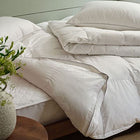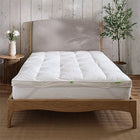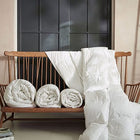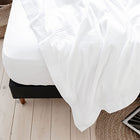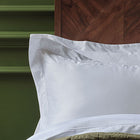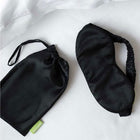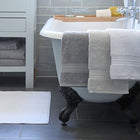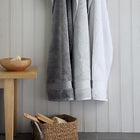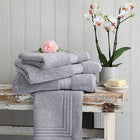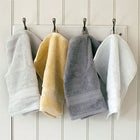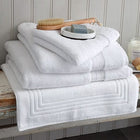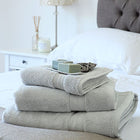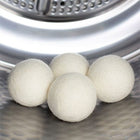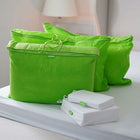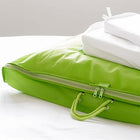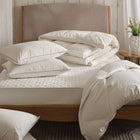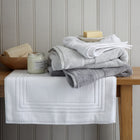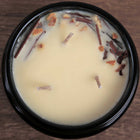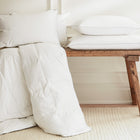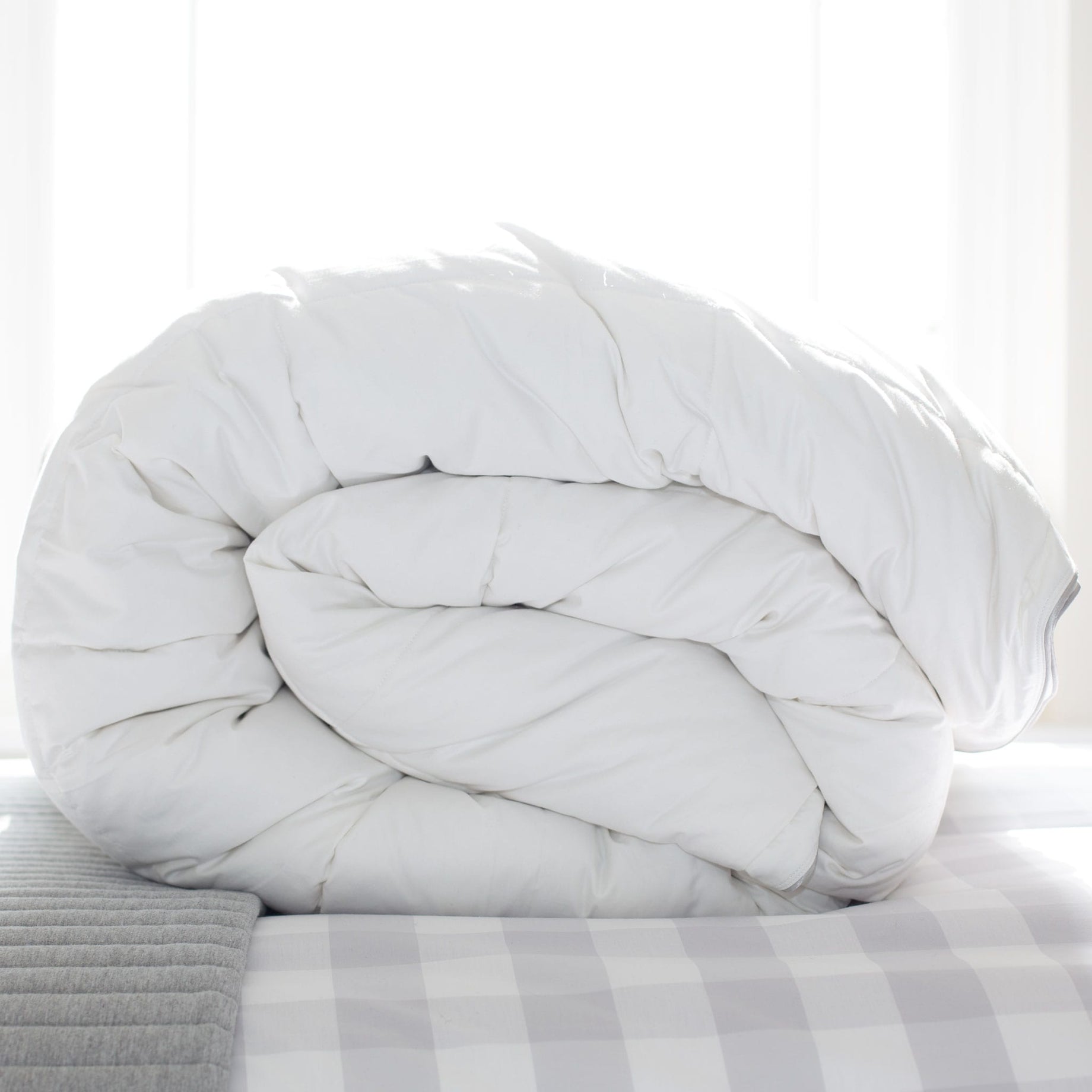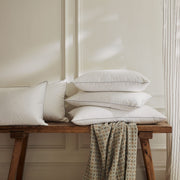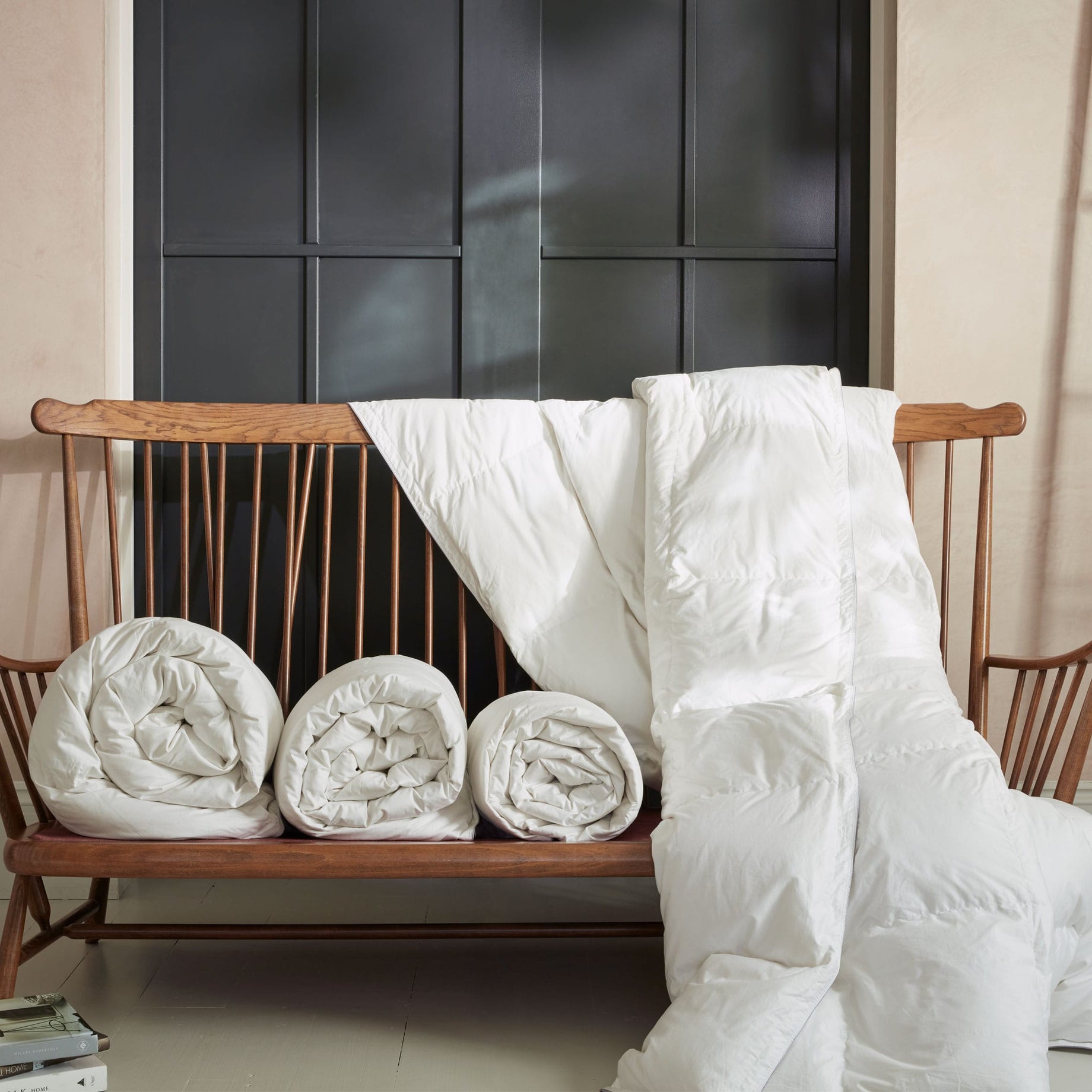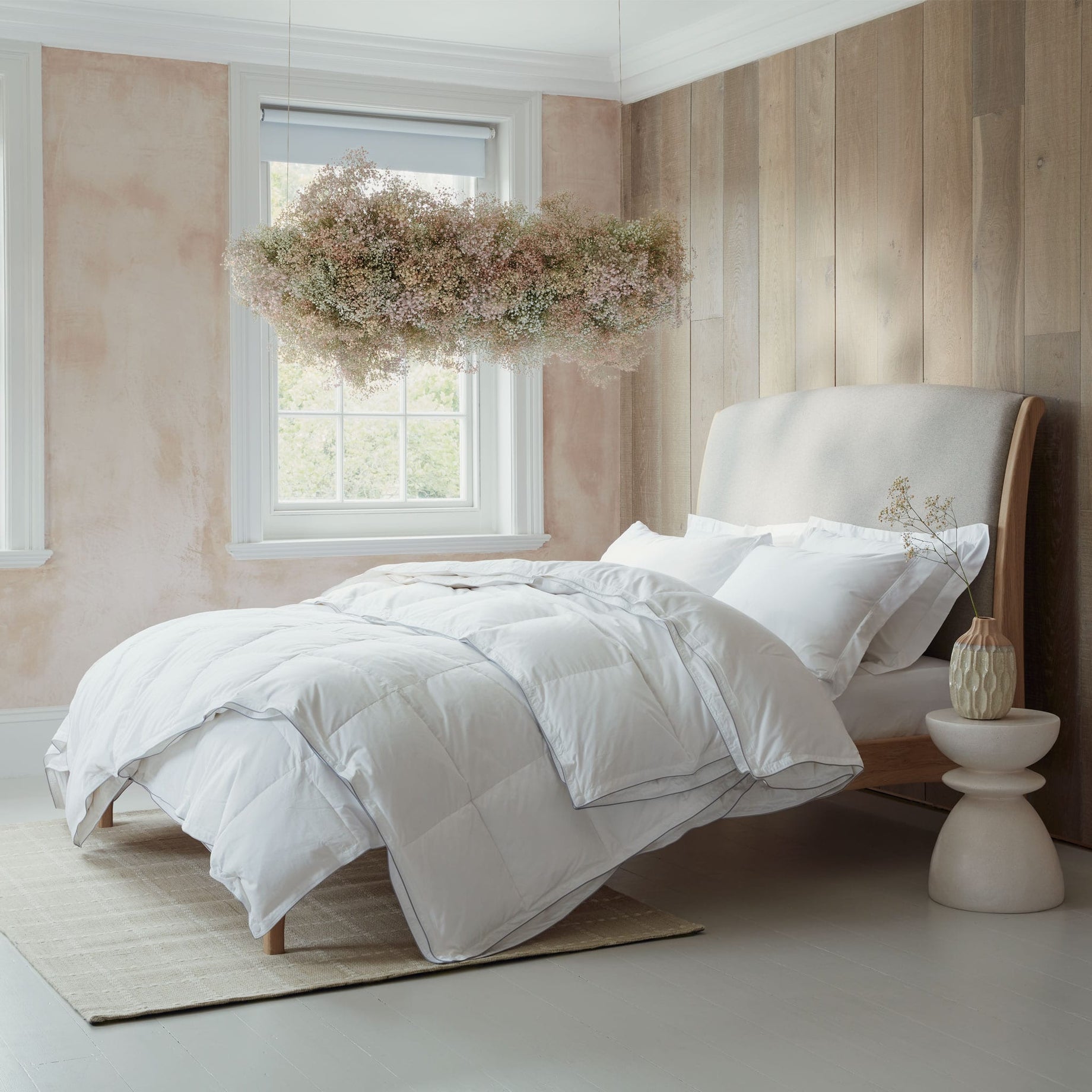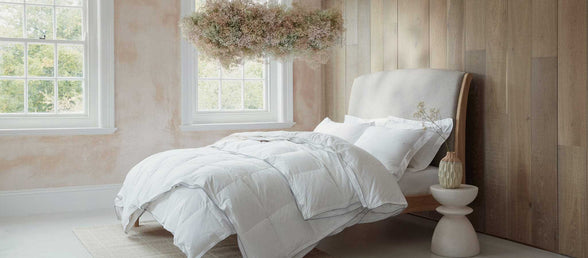
How to choose the best duvet: 10 things you need to know
Our best duvet buying guide covers the 10 most important things to think about when buying a duvet: duvet tog rating, best duvet filling, fill power & weight, how the duvet is made and the environmental impact. Plus, sizes, anti-allergy bedding, accreditations to look for, packaging and how to care for your duvets. Click here to read what customers say about our duvets.
TOG ratings
So, what does tog stand for and what tog duvet should you get?
The tog rating tells you how warm the duvet is and how insulating it will feel to sleep under, so it’s important to understand which tog rating is best for you and for the season. If you’re too hot or too cold in bed, you won’t get a good night’s sleep and you could be just a little bit grumpy the next day! Having the right tog rating will help to regulate your body temperature and sleep better. To find out which tog is best for you view our duvet tog guide.
The tog rating scale starts at a cool 1 tog to a very toasty 15 tog. It shows how good a duvet is at trapping air and providing warmth. Essentially, the higher the tog rating, the warmer the duvet. So, what is the best type of duvet to buy? You will most likely not want to sleep under the same tog duvet all year round.
Generally, you sleep best if your body remains at a cool to normal temperature throughout the night. 18C / 65F is about the right temperature to keep your bedroom. You will also sleep better if your duvet is the right tog for that season:
Summer duvets - 2.5 tog to 4.5 tog is the ideal tog duvet for the summer months, as it is less insulating and lighter weight. A natural duvet filling like goose down, wool or bamboo will be breathable and moisture wicking, helping to cool your body temperature. Find out everything you need to know about summer duvets in our Summer Duvet Guide.
Spring and autumn duvets - 4.5 tog to 9 tog will keep you warmer when the nights are colder in the spring and autumn. In modern well-insulated houses, then this tog rating will be enough to keep you warm throughout the winter months too.
Winter duvets - 9 tog, 10.5 tog and up to 13.5 tog duvets are very warm and cosy for those chilly winter nights. Ideal if you live in a colder environment but probably too warm in a well-insulated house. A 15 tog duvet is probably the warmest duvet tog available and only suitable if you really feel the cold!
All season duvets - Also called a 3-in-1 duvet, consisting of two duvets of different togs that can be used separately or fastened together to make up a warmer duvet. Usually one duvet is a lower tog summer duvet and the other is a higher tog autumn duvet.
At Scooms, we make 3 different all season duvets:
- 13.5 tog all season duvet: 4.5 + 9 tog
- 11.5 tog all season duvet: 2.5 + 9 tog
- 7 tog all season duvet: 2.5 + 4.5 tog
All our duvets have buttonholes for easy duvet pairing and can be fixed together with cufflink style fasteners. If you lose one of your duvet fasteners, just get in touch at sleep@scooms.com and we will send you a replacement pack of duvet fasteners.
Buying an all season duvet is generally a more cost effective option as buying the two duvets together will be cheaper than buying them separately. Make sure the all seasons duvet comes with a handy storage bag so that you can easily pack the extra duvet away when you're not using it. Find out more in our All season duvet guide.
Duvets for children - As young children can overheat more easily than adults, we recommend that they use a lower tog 2.5 or 4.5 tog single size duvet. But only if they are old enough to be using a full size bed.
Duvet fillings
Which duvet filling is best? The duvet filling is what makes a duvet feel totally amazing or utterly awful! Good quality duvets will have good quality fillings. There are two main types of duvet filling to choose from, natural or synthetic. The duvet casing is also important. We would always recommend a cotton casing as it is breathable, temperature regulating and sweat wicking. Read our duvet filling guide.
- Down duvets
- Feather duvets
- Down & feather duvets
- Silk duvets
- Wool duvets
- Microfibre duvets
- Hollowfibre duvets
- Soft as down duvets
- Regenerated or recycled hollowfibre duvets
Natural duvet fillings
Natural fillings are soft, warm, fluffy and more breathable than synthetic materials. There is no need to fret over duvet hygiene and care, the majority of natural fillings are machine washable, durable and biodegradable.
Down and feather fillings are the most popular natural duvet fillings, both goose and duck. Check the labelling or packing to make sure the down used is ethical down and a by-product of the food industry. Scooms adheres to The Responsible Down Standard which ensures that our goose down and feather is ethically sourced, traceable and rigorously tested.
Natural filled duvets using goose or duck down or feather have better thermal insulation than synthetic duvets. This means you don’t need as much filling to achieve the same tog rating, often making them lighter. Scooms duvets use 90% white Hungarian goose down and 10% white Hungarian small goose feather to add a little weight. Try our luxury Hungarian goose down and feather duvet, the best duvet that you will ever sleep under!
Down filled duvets: Down is the best natural insulator providing approximately three times more warmth than synthetic materials. Soft and fluffy, down is very durable and provides the highest levels of warmth in a duvet. You will see Hungarian goose down duvets (like Scooms!), European and Canadian down duvets.
If you have a dust mite allergy, look out for the Nomite certification when buying down duvets. The Scooms pillow and duvet are Nomite approved, certifying that they are suitable for house dust mite allergy sufferers.
Feather duvets: Heavier, larger and probably cheaper than down, feathers can be a bit spiky if the cover fabric isn’t robust enough.
Down & feather filled duvets: Most duvets use a mix of down and feather to provide a good amount of both weight and warmth. A higher ratio of down to feather will give you a lighter and warmer duvet.
Goose down v duck down duvets: Goose down clusters are larger than duck down clusters which means that goose down is more insulating, softer and lighter. Duck down is cheaper to produce so duck down duvets can be less expensive. But if you love luxury, choose a goose down duvet!
Recycled down filled duvets: These duvets are filled with recycled down and/or recycled feathers. Whilst a recycled down filled duvet can be a good idea environmentally, the down will have been put through various cleaning processes so it may have lost some of its beneficial properties. Recycled down duvets and recycled feather duvets can be a cheaper alternative to a luxury down duvet.
Silk duvets: Not widely available but a very durable and lightweight duvet filling. It is hypoallergenic, provides good temperature regulation and can be both washed and tumble dried. It will lose its natural properties though if over-washed.
Wool duvets: Naturally hypoallergenic, durable and recyclable. The chunky structure of wool means it traps air really well, providing good temperature regulation. Wool fillings wick away moisture from the skin and retain dry air and warmth. A wool duvet can however, feel a bit heavy and it won't have the comfortable drape of a down duvet. It may also have a bit of a 'wool' smell.
Synthetic duvet fillings
Often hypoallergenic because they can be washed regularly at higher temperatures, they can be a good option if you are allergic to feathers or wool. Whilst synthetic duvets can be sweat wicking, they are less breathable than natural fibres, so we would not recommend one if you are a hot sleeper or have night sweats.
Synthetic fibres can be manufactured to different widths of thickness and quality so make sure the duvet feels well filled.
Unfortunately, as synthetic duvet fillings are made from a form of plastic, they are not recyclable and do not biodegrade so they will end up in land fill when you dispose of them. When they are washed, they can also release microplastics into the environment. See our blog - Is there plastic in your bedding?
Microfibre duvets: Fine synthetic fibre made from polyester. The threads are finer than a human hair. Microfibre is intended to be the synthetic man-made equivalent to natural down. It is cheap to mass produce in vast quantities. The fine fibres are soft and silky. Really good quality microfibre can give the feel of a high ratio down duvet but it can’t match down’s loft and airiness.
Hollowfibre duvets: A polyester similar to microfibre but each strand of fibre has a single hole down the centre that traps air. As with microfibre, it is cheap to mass produce. The hollow fibres are lightweight, wiry and firm. Particularly durable and often inexpensive. Traps warmth fairly well and provides greater loft than microfibre.
Soft as down duvets: Another name given to microfibre.
Regenerated or recycled hollowfibre duvets: Sometimes called re:down or rPET. Waste plastic bottles are melted into plastic chips and then spun into polyester fibres. This requires less energy compared to virgin polyester and reduces the extraction of petrochemicals from the environment. It takes around 120 plastic bottles to produce the filling for a double duvet. Recycling reduces landfill so they are a better choice if you want a microfibre duvet but they may still create microfibre plastic pollution.
Fill power and fill weight
Fill power and fill weight are two different measurements. Both measurements can give you a good idea of the quality of the duvet you’re considering buying. Fill power measures the volume taken up by the down or feather filling in a duvet. Fill weight measures the weight of a duvet filling. Read our guide.
Fill power: This tells you about the down filling’s insulating ability, essentially the ‘loft’ or ‘fluffiness’ of the down. A high fill power means that the down is light, airy and breathable due to a greater number of air chambers. So, fill power is a great indicator of the quality and effectiveness of the down or feather to insulate. The higher the fill power, the better the duvet will be at keeping you warm.
A duvet with higher fill power will also be lighter, recover its fullness more easily when shaken in the morning and be more durable, so it will last longer.
Fill power can range from 450 to 900 with good fill power being 600 CUIN and above, (cubic inches per ounce).
Scooms duvets have 700 CUIN fill power, which is the highest fill power for down that is a by-product of the food industry.
Fill weight: The weight of the duvet filling is often measured in ‘gsm’, which means the weight of the filling within a square metre. The higher the fill weight, the heavier the duvet. Scooms 9 tog duvets are 180gsm, 4.5 tog duvets are 110gsm and 2.5 tog duvets are 80gsm. See our duvet weight guide below.
Fill weight also determines how soft or firm a duvet is. A heavy duvet does not equal a warmer duvet. Fill power not fill weight measures the effectiveness and quality of a down or feather duvet filling. So, a duvet with high fill weight but low fill power will be heavy and provide poor insulation.
The fill weight of Scooms duvets in grams (not the total duvet weight):
- Single duvet: 9 tog - 486g, 4.5 tog - 302g, 2.5 tog - 220g, All season - 788g
- Double duvet: 9 tog - 720g, 4.5 tog - 448g, 2.5 tog - 320g, All season - 1168g
- King size duvet: 9 tog - 911g, 4.5 tog - 567g, 2.5 tog - 400g, All season - 1478g
- Super king size duvet: 9 tog - 1030g, 4.5 tog - 641g, 2.5 tog - 480g, All season - 1671g
Duvet construction
How a duvet is made is also important to make sure the filling stays evenly distributed as you sleep and doesn’t leave you with any chilly bits! There are two main types of duvet construction - box stitch and baffle box.
Both box and baffle stitched duvets have multiple pockets that hold equal amounts of down or feather, ensuring an even spread across the duvet and preventing the filling ending up by your toes during the night!
Box stitch construction: Also called ‘sewn through’, the top and bottom cover are sewn together in a criss cross pattern which forms boxes. The stitching makes sure the same amount of down filling is held in each box.
We use the box stitch method for our lighter duvets, our 2.5 tog and our 4.5 tog down duvet. This stitch is generally the best type of construction for lower tog duvets as less down filling and space is needed.
Baffle box construction: Trickier to make, strips of material are sewn between the top and the bottom layer of material in a criss-cross pattern to form cubes. The cube shape allows for greater volume of filling than the box stitch construction, which is why we use this method for our 9 tog goose down duvets. This allows more space for the filling to ‘float’ and breathe, without being compressed, keeping our goose down duvet nice and fluffy!
Duvet sizes
UK duvet and mattress sizes are generally a standard size. But If your bed or mattress wasn't made for the UK market, make sure you measure your mattress before buying new bedding.
Here's our guide to standard UK duvet and mattress sizes:
- Single duvet: 135 x 200cm (4ft 5" x 6ft 7") / Mattress: 90 x 190cm
- Double duvet: 200 x 200cm (6ft 7" x 6ft 7") / Mattress: 135 x 190cm
- King size duvet: 225 x 220cm (7ft 4" x 7ft 3") / Mattress: 150 x 200cm
- Super king size duvet: 260 x 220cm (8ft 6" x 7ft 3") / Mattress: 180 x 200cm
Check our Bedding size guide before buying your duvet.
Our duvet tips:
- If you share a bed and your other half likes to roll over and take all the duvet, or you just like more duvet to drape over you, you may want to choose a duvet one size larger than your bed size! A larger size duvet can also look rather attractive as it drapes over the edge of the bed.
- The width of a King size duvet is slightly more than its length, so make sure you have the duvet the right way round when you put on your duvet cover.
- And if you’re particularly tall and your feet do reach the end of your bed, make sure your duvet is 30cm longer than you are. Otherwise, you might get cold toes or shoulders!
- Your duvet and duvet cover should always be the same size. They will be described in exactly the same measurements as duvet covers are made to fit the same size duvet.
Anti allergy duvets
You only need anti-allergy bedding if you are allergic to the particular filling. So, if you are allergic to wool, don’t get a wool duvet for your room. If you are allergic to feathers, don’t get a feather or down duvet. Learn more in our guide to Anti-allergy duvets and pillows.
The majority of bedding allergies are actually to dust mites. Dust mites don't care what kind of filling your duvet has, they just like damp warm conditions. Yuck! Look out for the NOMITE mark, an anti-allergen standard showing that a product is suitable for house dust mite allergy sufferers.
Studies have shown that synthetic bedding can harbour more allergens because the casing weave is often looser, allowing the mites to get in. Synthetics are also less breathable resulting in damper conditions that allow the mites to thrive.
The most important thing is to make sure that your bedding doesn't create an environment for dust mites. At Scooms we do this by:
- Having specially tightly woven casings on our duvets and pillows so that the tiny gaps between the cotton fibres are too small for the mites to get in.
- Using specially selected down which is naturally breathable, reducing moisture and damp conditions.
Make sure you care for your duvet and pillow properly too:
- Air your bed every morning by folding back the duvet to reduce any moisture from sweat.
- Wash your duvet and pillow according to the care label instructions.
Important duvet accreditations to look for
As well as the Nomite Mark, there are other important standards and accreditations you should keep an eye out for, depending on which type of filling you are considering.
Look out for these top independent industry certifications:
- Nomite - anti-allergen standard for house dust mite allergy sufferers.
- Oeko-Tex 100 - verifies tested against harmful toxins and chemicals.
Plus, for down and feather fillings like Scooms duvets:
- Single country source; by-product of the food industry.
- Downafresh - feather and down hygiene and cleanliness requirements to European standard EN 12935.
- Responsible Down Standard - ensuring down and feathers come from geese that have been treated well and never suffer from live-plucking; following the chain of custody from farm to product.
- Original Hungarian Goose Down Product certification - provided by the Hungarian Chamber of Commerce. Guaranteeing that the down and feather is genuine Hungarian. (Without this, your 'Hungarian goose down' could come from any country and may not actually be down from geese.) Every Scooms duvet and pillow comes with this certification.
Consider the impact of your packaging:
- We only use Forest Stewardship Council (FSC) accredited recyclable cardboard boxes to post our bedding, sealed with a paper based tape.
Small batch production
Scooms duvets (and all our other bedding) are made for us in small batches. That means we don’t have duvets or pillows sitting in a warehouse for ages or down that has been stored for a long time waiting to be filled into a duvet or pillow. And you get fresh, newly made bedding!
Environmental impact
Also consider the environmental impact of your duvet choice. "Buy well, buy once!" A good quality duvet will long outlast a cheap one and could therefore be a better investment.
Natural fillings such as down, feather and wool, unlike synthetic fillings, are biodegradable, take less energy to produce and don’t contain plastic microfibres. Synthetic bedding will most likely end up in landfill after it's thrown away.
Duvets and pillows are not generally recyclable but you can find some other uses for natural bedding. You can put down, feathers and wool from old natural duvets out for nesting birds. You could also give your old washed bedding to a pet or perhaps to an animal shelter. See our blog on Recycling feathers and down from your duvet.
The microfibres in microfibre, hollowfibre, soft as down, down alternative fill and recycled microfibre duvets are all microplastic pollutants. Because they are so small, treatment plants cannot effectively filter out all microfibres after washing. Like other microplastics such as microbeads, these tiny microfibres can enter the rivers, lakes, oceans and land food chains and be present in the air we breathe. Discover more in our blog: Is there plastic in your bedding.
Avoiding chemical nasties and plastic packaging
Make sure you know how the bedding you're buying has been treated. Is it free from toxins and chemicals? Our duvets are washed in thermal spring water without harsh chemicals. Check the label and packaging for the Oeko-Tex 100 symbol which verifies that the product has been tested against harmful toxins and chemicals.
And is the packaging reusable and recyclable? Many duvets and pillows are wrapped in single use plastic packaging but this almost always ends up in our seas or in landfill. All Scooms duvets are delivered in a reusable material bag in a FSC certified cardboard box, without any plastic wrapping or paper inserts.
“We have to act now to try and clear up some of the appalling damage we have made… and that is going to require positive action,” Sir David Attenborough.
Washing your duvet
Different duvet fillings and materials may have different washing instructions, so always follow the instructions on the care label.
Try to reduce the amount of times you wash a microfibre duvet as the fibres are microplastics, which water treatment plants find difficult to filter and can get into the food chain.
How to wash & dry your Scooms duvet:
- Wash your Scooms duvet every 6 to 12 months.
- Machine wash at 40° - you may need to take your duvet to the laundrette unless you have a large drum capacity machine.
- Use non-bio (enzyme free) detergent - about a third of the usual amount.
- Dry thoroughly and tumble dry if necessary - make sure your duvet filling is completely dry before you place it in your duvet cover.
- Read our duvet care guide carefully before washing your duvet - How to care for & clean your goose down duvet.
Where to buy duvets near me?
If you are looking to buy a duvet, buying online from Scooms is a really easy and risk free way to buy. We offer a 60 night trial with free UK returns and a full refund so you can make sure you love your Scooms duvet and that you've chosen the right tog for you.
It will save you the effort of having to carry a large box home! Plus, you can quickly see what's in stock and read all the product details in your own time from the comfort of your own home or anywhere you choose! Order online for free next day UK delivery on all our duvets. What could be easier!
If you need to talk to an expert, call Emily or Jonathan on 020 7164 6045 or email us at sleep@scooms.com.
Also take a look at our mattress topper guide. Our Goose down & feather toppers are made to the same rigorous standards as our duvets.
How to choose a duvet FAQs:
What is the best filling for a duvet?There are two main types of duvet filling to choose from, natural or synthetic. Natural fillings provide superior insulation and are more breathable than synthetic materials. Down filled duvets and feather filled duvets are the most popular natural duvet fillings. A goose down filled duvet is preferable to a duck down filled duvet or a feather filled duvet as the larger down clusters trap more air so they are warmer and softer. Which duvet is best for summer?A 2.5 tog duvet or 4.5 tog duvet is ideal for warm summer nights or if you are a hot sleeper. The best summer duvets will help you avoid sleeping badly and then waking up feeling sticky and tired. As well as the tog rating, you should check the breathability of the summer duvet casing and filling. A summer duvet with good breathability will help any moisture from sweat to escape more easily. Naturally breathable duvet fillings, like goose down, offer up to four times better air circulation than synthetic duvet fillings. Which duvet is best for winter?A 9 tog to 13.5 tog duvet is a good tog rating if you get cold in bed during the winter and a 4.5 tog if you are a hot sleeper. An all season duvet offers the most versatility if you want a duvet you can use all year round. An all season duvet is a set of 2 duvets, combining a lower tog duvet with a higher tog duvet, that often comes with a cost saving. Typically, a 4.5 tog duvet is paired with a 9 tog duvet giving you a summer heat duvet and a winter heat duvet that can be combined to make a very toasty 13.5 tog if you need it. How long should a duvet last?The Sleep Council recommends changing your duvet every five years, although this depends on the quality of your duvet and how well you look after it. Better quality duvets can last longer. Wash your duvet once every 6 to 12 months and refresh it in between by airing it outdoors. Use a good quality cotton duvet cover to protect your duvet and wash your bedding weekly. What is 100 down duvet?Another name for a 100% down duvet. If you like a light, floaty duvet then a 100% down filled duvet could suit you. However, if you want your duvet to wrap gently around you as you sleep and not move when your partner rolls over, choose a duvet filling that includes a small amount of fine feathers. A 90% down and 10% feather filled duvet is ideal for a duvet filling if you like a little weight and can be much more snuggly! |
